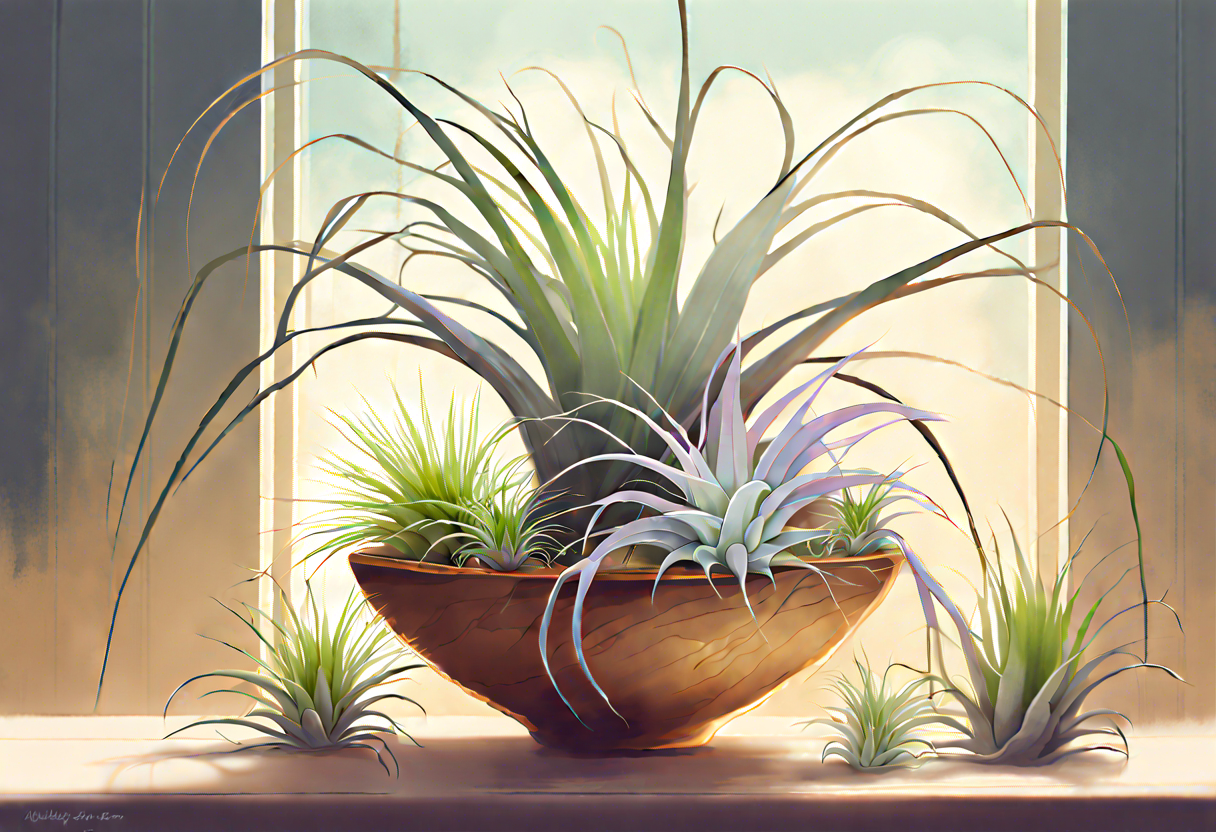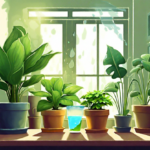Understanding the Basics: Key Tips for Caring for Air Plants Indoors
Air plants, also known as Tillandsia, are unique and low-maintenance plants that can thrive indoors. They don’t require soil to grow, but rather absorb nutrients through their leaves. If you’re new to caring for air plants, it’s important to understand the basics to ensure they stay healthy and vibrant in your indoor space.
One of the first things to consider when caring for air plants indoors is the ideal environment. Air plants thrive in areas with good air circulation and moderate temperatures. It’s advisable to place them in a room with a temperature range between 50 to 90 degrees Fahrenheit. Avoid exposing air plants to extreme temperatures, such as near heating vents or air conditioning units, as it can cause stress and damage to the plants.
Light is another crucial factor for the health of your air plants. While they don’t require direct sunlight, they do need bright, indirect light to thrive. Place your air plants near a window with filtered or diffused sunlight. Avoid placing them in areas with harsh, direct sunlight as it can scorch their leaves. If your indoor space lacks sufficient natural light, you can supplement it with artificial grow lights specifically designed for plants. Position the lights about 6 to 12 inches above the plants for optimal growth.
Watering air plants is different from watering traditional potted plants. Instead of soaking their roots in water, air plants are best watered through misting or soaking methods. Misting involves lightly spraying the plants with water using a spray bottle. Mist your air plants every 2 to 3 days, ensuring the leaves are thoroughly moistened. Alternatively, you can soak your air plants in water for about 20 to 30 minutes once a week. After soaking, gently shake off any excess water to prevent rotting.
In addition to regular misting or soaking, air plants also benefit from occasional fertilization. Although they can survive without fertilizers, providing them with a balanced, water-soluble fertilizer can enhance their growth and blooming. Dilute the fertilizer to half or one-quarter of the recommended strength and apply it to the plants once a month during their active growing season, which is typically spring and summer. Avoid fertilizing during the winter months when the plants are in a dormant phase.
To keep your air plants healthy, it’s important to inspect them regularly for signs of pests or disease. Look out for yellowing or browning leaves, which could indicate overwatering or inadequate light. If you notice any pests like mealybugs or spider mites, you can gently wipe them off with a cotton swab dipped in rubbing alcohol.
Caring for air plants indoors requires providing them with an optimal environment, adequate lighting, regular misting or soaking, occasional fertilization, and diligent pest control. By following these key tips, you can enjoy the beauty of air plants in your indoor space and watch them thrive with minimal effort.
Choosing the Right Location: Creating the Ideal Indoor Environment for Air Plants
When it comes to caring for air plants indoors, one of the most crucial aspects is choosing the right location for your plants. Creating the ideal indoor environment will ensure that your air plants thrive and flourish. Here are some key factors to consider when selecting the perfect spot for your air plants.
1. Natural Light
Air plants thrive in bright, indirect light. Place them near a window where they can receive ample natural light throughout the day. However, it’s important to avoid placing them in direct sunlight, as this can lead to leaf burn. If you have a south or west-facing window, it’s best to use a sheer curtain or window film to filter the intense sunlight and prevent any damage to your plants.
2. Temperature and Humidity
Air plants prefer temperatures between 50°F (10°C) and 90°F (32°C). Avoid exposing them to extreme temperatures, as this can cause stress and damage to the plants. Additionally, air plants thrive in high humidity environments. If your home tends to be dry, consider using a humidifier or creating a humidity tray by placing water-filled pebbles or rocks beneath the plant.
3. Air Circulation
Air plants require good air circulation to prevent stagnant air and ensure proper transpiration. Avoid placing them in closed containers or areas with limited airflow. Instead, choose an open space where air can circulate freely around the plants. This will help prevent rot and fungal diseases that can be caused by excessive moisture or lack of air circulation.
4. Proper Air Plant Display
When considering the location for your air plants, it’s essential to choose appropriate displays or containers. Air plants can be mounted on various surfaces such as driftwood, cork, or stones, or placed in decorative containers like glass terrariums or hanging planters. Ensure that the displays or containers you choose allow proper air circulation and drainage. Avoid using containers that trap moisture, as this can lead to rotting of the plants.
5. Avoiding Drafts and Extreme Conditions
Avoid placing your air plants near drafty areas such as open windows, air vents, or doors. Exposure to drafts can cause temperature fluctuations and dry out the plants. Additionally, keep your air plants away from extreme conditions such as heaters, air conditioners, or fireplaces, as these can also lead to stress and damage.
By selecting the right location and creating the ideal indoor environment, you can provide the best conditions for your air plants to thrive. Remember to monitor the light, temperature, humidity, air circulation, and display of your plants to ensure their health and longevity. With proper care, your indoor air plants will add a touch of greenery and beauty to your space.
Proper Hydration: Watering Techniques for Healthy Air Plants
Air plants, also known as Tillandsia, are unique plants that don’t require soil to grow. They gather nutrients and moisture from the air, making them a popular choice for indoor gardening. To ensure your air plants thrive, it’s essential to understand proper watering techniques. Here are some tips on how to properly hydrate air plants for optimal growth.
Understanding Air Plant Needs
Before diving into watering techniques, it’s important to know your air plant’s specific requirements. Air plants generally hail from tropical and subtropical regions, where they receive ample rainfall and humidity. They prefer to be moist but not waterlogged. Remember, overwatering can lead to root rot and other issues. Having a grasp of their natural habitat will help you provide the ideal conditions for their growth.
Mist Your Air Plants
One common and effective way to hydrate air plants is through misting. Fill a spray bottle with room temperature, chlorine-free water, and mist your plants two to three times a week. When misting, make sure the water evenly covers all the plant’s leaves. Using a fine mist setting will help prevent damage to the delicate foliage.
Soak and Dry Method
Another popular watering technique for air plants is the soak and dry method. Every one to two weeks, submerge your air plants in a bowl or sink filled with room temperature water. Allow them to soak for 20-30 minutes. Afterward, gently shake off any excess water and place them upside down on a towel to dry. Ensure the plants are completely dry before returning them to their display area.
Consider Your Environment
The frequency of watering your air plants depends on various factors like humidity levels, temperature, and air circulation in your home. If you live in a dry climate or have central heating, your air plants might need more frequent watering. On the other hand, in humid environments, you can reduce the watering frequency. Monitor your plants’ moisture levels and adjust your watering schedule accordingly.
Avoid Tap Water and Overfertilizing
It’s crucial to use chlorine-free water for your air plants. Chlorine and other chemicals present in tap water can harm the plants’ delicate leaves. If you don’t have access to rainwater, use filtered or distilled water instead.
Additionally, air plants require minimal nutrients compared to other plants. Overfertilizing can harm their delicate root system. Use a water-soluble, low-nitrogen fertilizer diluted to one-quarter strength and apply it every two to four weeks during the growing season.
Final Thoughts
Proper hydration is key to keeping your air plants healthy and thriving indoors. By misting or using the soak and dry method, considering your environment, and avoiding tap water and overfertilizing, you can ensure your air plants receive adequate moisture without risking their well-being. Remember, each air plant is unique, so pay attention to their individual needs and adjust your watering routine accordingly. With proper care, your air plants will continue to beautify your indoor space for years to come.
Providing Adequate Light: Exploring the Best Lighting Options for Indoor Air Plants
When it comes to caring for air plants indoors, providing adequate light is crucial for their growth and overall health. These unique plants, also known as Tillandsia, thrive in bright, indirect light. Here, we will explore the best lighting options to ensure your air plants receive the light they need to flourish.
Natural Light:
One of the easiest and most cost-effective ways to provide light for your indoor air plants is through natural sunlight. Place your air plants near windows with bright, indirect light. East or west-facing windows are ideal as they receive ample sunlight without the intense heat of direct afternoon sun.
Artificial Light:
If natural light is limited in your home or office, you can supplement it with artificial light sources. LED grow lights are a popular choice for air plants as they emit the right spectrum of light for optimal growth. Position the grow lights within 6 to 12 inches (15 to 30 cm) of your air plants, ensuring they receive light for 12 to 14 hours a day.
Choosing the Right Bulb:
When selecting LED grow lights for your air plants, look for bulbs that emit full-spectrum light. This closely mimics natural sunlight and provides the necessary wavelengths for photosynthesis. Additionally, choose bulbs with a higher Kelvin (K) rating, ideally between 5000K to 6500K, as this provides a balanced light spectrum that promotes healthy growth.
Lighting Duration:
While air plants need ample light for optimal growth, it’s equally important to give them a period of darkness. Aim for a lighting schedule of 12 to 14 hours of light followed by 10 to 12 hours of darkness. This allows the plants to rest and rejuvenate, ensuring their overall well-being.
Adjusting Light Intensity:
As each indoor environment is different, it may take some experimentation to find the right amount of light for your air plants. Monitor your plants closely and observe their growth. If you notice any signs of burning or bleaching, reduce the intensity and duration of light exposure. On the other hand, if your air plants are growing tall and stretching towards the light, they may need stronger or closer light sources.
Seasonal Adjustments:
Keep in mind that the light requirements for air plants may change with the seasons. During the winter months, when sunlight is weaker and days are shorter, you may need to supplement with artificial light sources more extensively. Conversely, during summer, your air plants may benefit from more exposure to natural sunlight, but ensure they are protected from direct, scorching rays.
By understanding the lighting needs of air plants and incorporating these best practices, you can create an ideal indoor environment for their growth and well-being. Whether you opt for natural light or supplement with artificial sources, providing adequate and appropriate light will help your air plants thrive and bring a touch of green beauty to your space.
Fertilizing Air Plants: Essential Nutrients and How to Feed Your Plants
Air plants may not rely on soil like other houseplants, but they still require nutrients to thrive. While they can absorb moisture and nutrients through their leaves, it’s essential to provide them with supplemental fertilizers to maintain optimal health and growth. In this guide, we’ll explore the vital nutrients that air plants need and how to properly fertilize them for vibrant foliage and beautiful blooms.
Understanding the Nutritional Needs of Air Plants
Air plants primarily rely on three essential nutrients: nitrogen, phosphorus, and potassium. Nitrogen is crucial for leaf development, phosphorus promotes root growth, and potassium enhances overall plant health. These macronutrients are essential for air plants to carry out their basic metabolic functions.
In addition to these macronutrients, air plants also require trace elements such as iron, magnesium, and calcium. These micronutrients play a vital role in various physiological processes, including photosynthesis and enzyme activation. While air plants can source some of these nutrients from their surrounding environment, supplementing with fertilizer ensures they have an adequate supply for optimal growth.
Selecting the Right Fertilizer
When choosing a fertilizer for your air plants, it’s crucial to opt for a water-soluble and balanced formula. A balanced fertilizer contains equal or near-equal ratios of nitrogen, phosphorus, and potassium (for example, a 10-10-10 or 14-14-14 formula). This balanced ratio ensures that your air plants receive all the necessary nutrients in the right proportions.
Avoid fertilizers with high nitrogen content, as this can lead to excessive leaf growth at the expense of root development. Additionally, it’s best to use a fertilizer specifically formulated for epiphytic plants or Tillandsias, as they have different nutrient requirements compared to plants rooted in soil.
How to Fertilize Air Plants
Fertilizing air plants is a simple process that can be carried out alongside regular watering. Here’s a step-by-step guide on how to properly feed your air plants:
-
Dilute the fertilizer: Follow the instructions on the fertilizer packaging to determine the appropriate dilution ratio. Generally, you’ll need to dilute the fertilizer at a rate of 1/4 to 1/2 strength.
-
Soak or mist: Depending on the size of your air plants, you can choose to soak them in the diluted fertilizer solution for 20-30 minutes or mist them thoroughly. Soaking is ideal for larger plants, while misting works well for smaller ones.
-
Drain excess water: After fertilizing, allow the excess solution to drain completely. Air plants should never sit in standing water, as it can lead to root rot.
-
Frequency of fertilization: Generally, air plants require fertilization every one to two months during the growing season (spring and summer) and less frequently during the dormant period (fall and winter). Adjust the frequency based on your specific air plant’s needs and the fertilizer’s instructions.
Remember, it’s better to under-fertilize than over-fertilize your air plants. Excessive fertilizer can cause root burn and other detrimental effects. Always monitor your plants’ response to fertilization and adjust accordingly.
Nurturing Healthy Air Plants
Fertilizing your air plants helps ensure they have the necessary nutrients for optimal growth and vitality. By understanding their nutritional needs, selecting the right fertilizer, and following proper fertilization techniques, you can nurture healthy air plants that will bring beauty and greenery to your indoor space for years to come.
Conclusion
Caring for air plants indoors can be a rewarding and enjoyable experience. By understanding the basics of air plant care and following key tips, you can ensure the health and optimal growth of your air plants. Choosing the right location is crucial, as it creates the ideal indoor environment for these unique plants.
When it comes to watering techniques, it’s important to strike the right balance. Overwatering can lead to rot, while underwatering can cause dehydration. By thoroughly soaking your air plants and allowing them to dry completely, you can provide them with the hydration they need without risking their health.
Providing adequate light is another critical factor for indoor air plant care. While these plants thrive in bright, indirect light, direct sunlight can burn their leaves. By placing them near a window with sheer curtains or using artificial lighting options such as fluorescent or LED lights, you can ensure they receive the right amount of light for optimal growth.
Fertilizing your air plants is essential to provide them with the necessary nutrients for thriving. While air plants typically absorb nutrients from the air and rain, supplementing their diet with a gentle fertilizer is beneficial. Using a water-soluble fertilizer with a low concentration of nutrients can help support their growth without risking damage.
It’s also worth noting that air plants require occasional care beyond the basics. They may need grooming to remove dead leaves or blooms, and pest control measures may be necessary if infestations occur. By regularly inspecting your plants and tending to their needs, you can ensure their longevity.
Understanding the basics of air plant care, choosing the right location, watering properly, providing adequate light, and fertilizing can help you create a thriving indoor environment for your air plants. With the right knowledge and attention, your air plants can prosper as unique and eye-catching additions to your indoor space. Embrace the wonders of air plant care and enjoy the beauty and tranquility they bring to your home or office.


